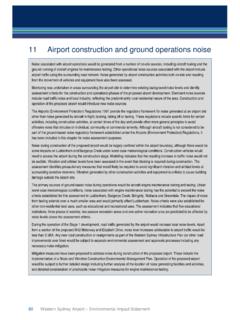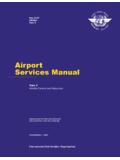Transcription of 7 Airspace architecture and operation - Western …
1 7 airspace architecture and operation Airspace overview A preliminary Airspace management analysis was conducted to establish whether safe and efficient operations could be introduced at the proposed Western Sydney airport through the development of indicative air traffic management designs and flight paths. The analysis indicates there are no known physical impediments that would prevent safe and efficient operations for aircraft arriving at or departing from the proposed airport . The indicative flight paths developed through the preliminary analysis were used to model and assess the impacts of aircraft operations in the EIS. The flight paths assessed in the EIS represent one possible Airspace design aircraft operations on different flight paths would result in different noise outcomes from those presented. For the purposes of an EIS, the use of indicative flight paths is a valid approach for identifying and assessing the nature and scale of impacts arising from operations at the proposed airport and is generally consistent with the environmental assessment approach for runway infrastructure developments at other airports.
2 The EIS has provided the opportunity for the community and stakeholders to consider the indicative flight paths and express views about their assessed impacts at an early stage in the Airspace design process. While the analysis based on the modelled indicative flight paths found that peak aircraft noise levels in the lower Blue Mountains would be below generally accepted thresholds for day and night time operations , comments in response to the draft EIS indicated significant community concern about the potential for flight paths to concentrate over a single point above the town of Blaxland. The Australian Government has announced that the Airspace design to be implemented for the proposed Western Sydney airport will not converge arriving aircraft at a single point over the community of Blaxland. There is substantial scope to develop new flight paths for arrivals and departures that minimise the overflight of residential areas and reduce the impact of aircraft noise on the communities of Western Sydney and the Blue Mountains.
3 Consistent with the Government's announcement, the detailed Airspace and flight path design for the proposed airport will apply international best practice for managing Airspace design and its associated environmental impacts. The flight path design process will optimise flight paths on the basis of safety, efficiency, capacity, and noise and environmental considerations, while minimising changes to existing Airspace arrangements in the Sydney basin. The use of relatively new satellite-based navigation technologies at the proposed airport will provide greater flexibility in planning flight paths and will allow a larger range of options to be considered for managing noise from both night and daytime operations . Extensive community and stakeholder engagement will occur throughout the flight path design process, which will commence after the airport Plan is determined by the Infrastructure Minister. An overview of the design process is presented in Section Key principles that will apply to the comprehensive Airspace and flight path design process for single runway operations include: overflights of residential areas and noise sensitive facilities will be avoided to the maximum extent possible.
4 Aircraft arrivals will not converge through a single merge point over any single residential area;. 224 Western Sydney airport the use of head-to-head operations to and from the south-west, when it is safe to do so, is an important preferred option for managing aircraft noise at night. This preferred option will be thoroughly evaluated through further detailed assessment; and in determining the final flight paths, the community, aerodrome operators and Airspace users will be consulted extensively and flight path designs will be subject to referral under the Environment Protection and Biodiversity Conservation Act 1999. The Department of Infrastructure and Regional Development will be responsible for delivering the flight path design for the proposed Western Sydney airport , working in close collaboration with Airservices Australia and the Civil Aviation Safety Authority (CASA). The proposed Airspace design arrangements will be formally referred under the Environment Protection and Biodiversity Conservation Act 1999 (EPBC Act).
5 CASA would ultimately approve the proposed Airspace management arrangements, including the authorisation of final flight paths, before the commencement of operations . Regulatory context Airspace is the term used for the three dimensional space in which aircraft are able to fly. Elements of Airspace include terminal Airspace , controlled Airspace and restricted Airspace . Terminal Airspace generally encompasses the area within 55 to 90 kilometres (30 to 50 nautical miles) from a major airport . The height of terminal Airspace varies depending on the operational parameters at an airport . In the case of Sydney (Kingsford Smith) airport (Sydney airport ), terminal Airspace extends from ground level up to about 6,000 metres (20,000 feet) close to the airport . As the distance from the airport increases, the lower boundary of this zone rises in steps, beginning at 300 metres (1,000 feet) and increasing to typically about 2,300 metres (7,500 feet) at the outer edges of the Sydney region.
6 Controlled Airspace includes the terminal Airspace area and also the Airspace along the flight paths between airports. Restricted Airspace includes all Airspace that has restrictions placed on its use. This is generally associated with military installations or other situations where additional precautions are warranted to enhance safe operations (for example, explosives storage facilities such as the Defence Establishment Orchard Hills). Flight paths define the anticipated routes of aircraft arriving and departing from an airport when operating on standard instrument departures or conducting approaches under instrument guidance, or under visual meteorological conditions. If the only factors to consider were those of operating efficiency, aircraft would fly by the most direct route and at the optimum altitude for reasons of economy and efficiency of flight operations . However, when other factors are taken account of, such as noise and safety considerations and the competing demands of other Airspace users, the optimum route will not necessarily be the most direct one.
7 When departing from an airport , an aircraft follows a predetermined flight path from the end of the runway until it is established on a route that leads ultimately to its destination. Because of the greater manoeuvring options available for aircraft after take-off, there is greater flexibility in determining flight paths for departing aircraft than for aircraft landing at an airport . Australian Airspace is largely available for civil aviation use, with overall responsibility for management of the Airspace shared by Airservices Australia and the Department of Defence. Western Sydney airport 225. CASA is responsible for Airspace regulation, while Airservices Australia manages the Airspace and provides the necessary air traffic control services and equipment to maintain a safe and efficient flow of air traffic. Day to day management of the Airspace is achieved through air traffic controllers who direct the various phases of flight. Air traffic management procedures are published for each airport including standard instrument departures, standard arrival routes as well as associated noise management procedures.
8 The efficient use of Airspace in the Sydney basin is influenced by the geographic location of airport sites. The relative proximity, in Airspace terms, between the proposed Western Sydney airport , Sydney airport and other existing facilities, such as Bankstown airport , means that aircraft operations need to be carefully coordinated. Runway orientation at the proposed airport is the major factor influencing the design of aircraft traffic flow patterns and flight path arrangements. Wherever operationally feasible, it is also desirable that aircraft traffic flow patterns are sufficiently flexible to minimise the effects of aircraft noise on surrounding residential and other noise sensitive areas. Potential Airspace parameters in the Sydney basin Existing Sydney basin Airspace A review of the existing Airspace arrangements in the Sydney basin was undertaken in March 2015. by CASA 7. The review considered the Airspace within 45 nautical miles (83 kilometres) of Sydney airport .
9 High levels of private operations , flight training activity, military operations and a range of other general and sports aviation activity combine to make the Sydney region one of the busiest and most complex volumes of Australian Airspace , supporting Australia's busiest international airport and a number of satellite airports and aerodromes. While the commencement of operations at the proposed airport is outside of CASA's current study period, the new airport is likely to trigger a separate Airspace study before the commencement of operations . The locations of prominent existing airports and aerodromes in the Sydney region are shown in Figure 7 1. Existing Sydney region Airspace controls The Sydney region Airspace comprises a number of zones that are set to control the safe and efficient function of the Airspace . These include: Class C and D control zones;. Class C and A control areas;. Class G uncontrolled Airspace ;. Restricted areas; and Danger areas.
10 There are no prohibited areas (no-fly zones) in the Sydney region Airspace . 7. The Sydney Basin Aeronautical Study (CASA 2015). 226 Western Sydney airport Sydney region Airspace controls would be reviewed and varied, as necessary, to accommodate the requirements of the proposed airport and ensure the safe and efficient function of the Airspace . These issues will be important considerations for the future Airspace and flight path design process described in Section Australian Airspace architecture Class A: This high-level en route controlled Airspace is used predominately by commercial and passenger jets. Only Instrument Flight Rule (IFR) flights are permitted and they require an air traffic control (ATC) clearance. All flights are provided with an ATC service and are positively separated from each other. Class C: This is the controlled Airspace surrounding major airports. Both IFR and Visual Flight Rule (VFR) flights are permitted and must communicate with air traffic control.







